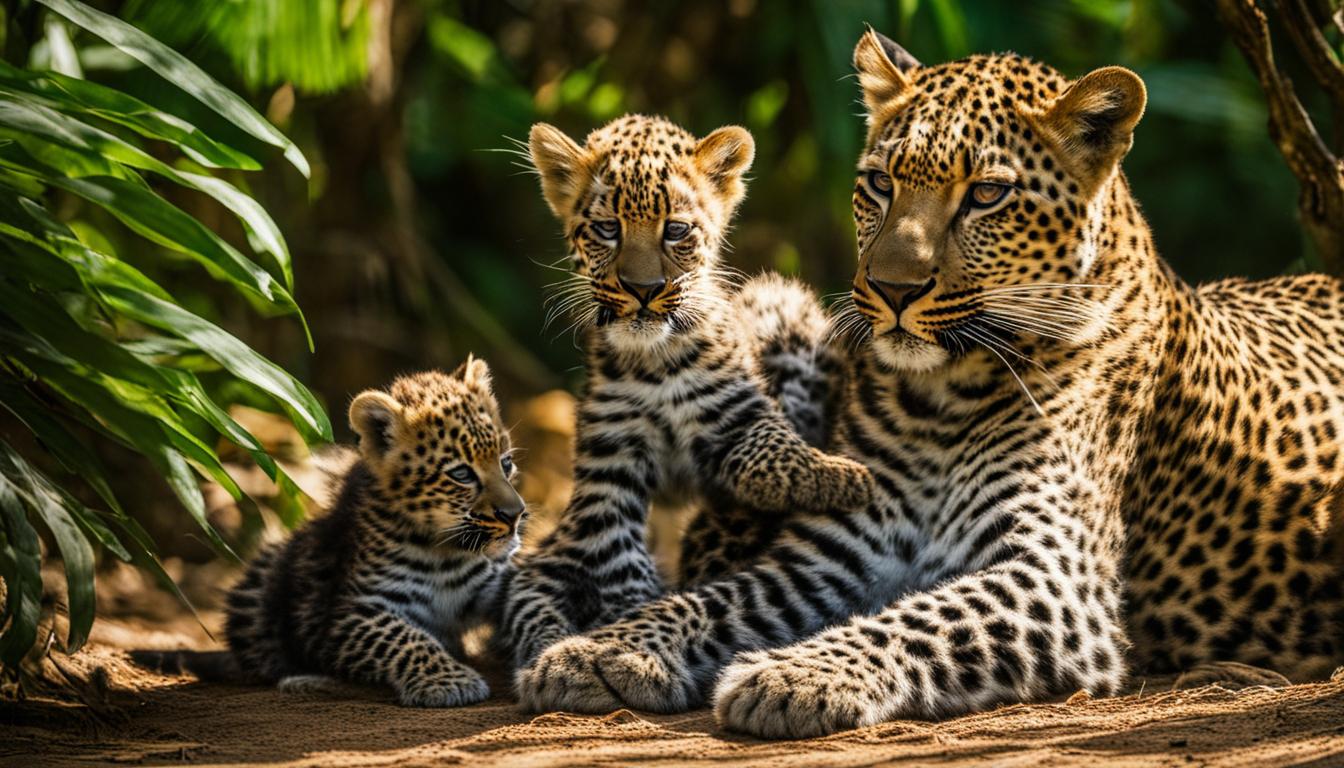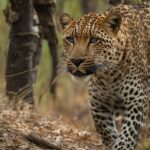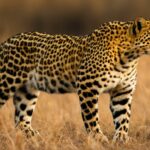Welcome to our article on leopard cubs! If you’ve ever wondered about leopard cub care and fascinating leopard cub facts, you’re in the right place. In this section, we’ll explore the incredible journey of how leopard cubs grow and develop under the loving care of their mother.
Leopard cubs are born small and helpless, relying entirely on their mother for care and protection. They enter the world blind and almost hairless, weighing just 17 to 21 ounces. The gestation period for leopards is between 90 and 112 days, and litters typically contain two cubs, although they can have up to six.
These adorable cubs depend on their mother for food and do not leave the den until they are 3 months old. It’s incredible to witness their growth and development as they gradually become independent hunters, ready to live on their own at 12 to 18 months old.
If you’re fascinated by the growth and development of leopard cubs, keep reading as we delve deeper into their journey and discover more about these magnificent creatures!
Growth and Development of Leopard Cubs
Leopard cubs go through various stages of growth and development as they mature into independent hunters. At around 7 days old, their eyes open, allowing them to take in their surroundings. By 2 months old, they are ready to start eating solid food, gradually transitioning from their mother’s milk. This period is critical for their nutritional needs and overall health.
By the time they reach 3 months old, leopard cubs begin following their mother and learning important hunting behaviors. They observe her techniques and hone their skills, developing the agility and stealth required to catch their prey. It’s fascinating to witness their progress as they grow more confident with each successful hunting experience.
“Leopard cubs are like sponges, absorbing everything they see and learn from their mother. It’s crucial for their development to have a strong role model teaching them the skills they need to survive in the wild.” – Wildlife Conservation Expert
However, for those interested in raising leopard cubs, it’s important to note that they require specialized care and attention. Their needs can be complex, and their behavior can be unpredictable. Therefore, leopard cub adoption should only be considered by qualified professionals with the necessary expertise and resources.
| Stage | Age | Key Development |
|---|---|---|
| 1 | 7 days old | Eye-opening |
| 2 | 2 months old | Transition to solid food |
| 3 | 3 months old | Follow mother and learn hunting behaviors |
| 4 | 18-22 months old | Become independent |
Leopard cubs undergo remarkable growth and development, guided by their mother’s teachings. It’s an incredible journey that shapes them into the majestic leopards they will become.
Life Expectancy of Leopard Cubs
When it comes to the life expectancy of leopard cubs, there are significant differences between those in captivity and those in the wild. In captivity, leopard cubs have the potential to live for as long as 23 years. However, in the wild, their life expectancy is shorter due to the challenges they face.
Wild leopards typically live for 12 to 15 years, with factors such as habitat loss and hunting contributing to their declining population. These beautiful creatures are not only threatened by human activities but also by natural predators and diseases. The harsh conditions of their natural habitat make it difficult for leopard cubs to survive into adulthood.
Conservation efforts play a vital role in protecting these magnificent creatures and ensuring their survival for future generations. Organizations and initiatives are working tirelessly to preserve leopard habitats, implement anti-poaching measures, and raise awareness about the importance of conservation. By supporting these efforts, we can help secure a brighter future for leopard cubs and their entire species.
| Leopard Cub Life Expectancy | In Captivity | In the Wild |
|---|---|---|
| Years | Up to 23 | 12 to 15 |
Through dedicated conservation initiatives, we can address the threats faced by leopard cubs and ensure their longevity. By preserving their natural habitats and promoting responsible tourism, we create opportunities for leopard cubs to thrive and flourish in the wild.
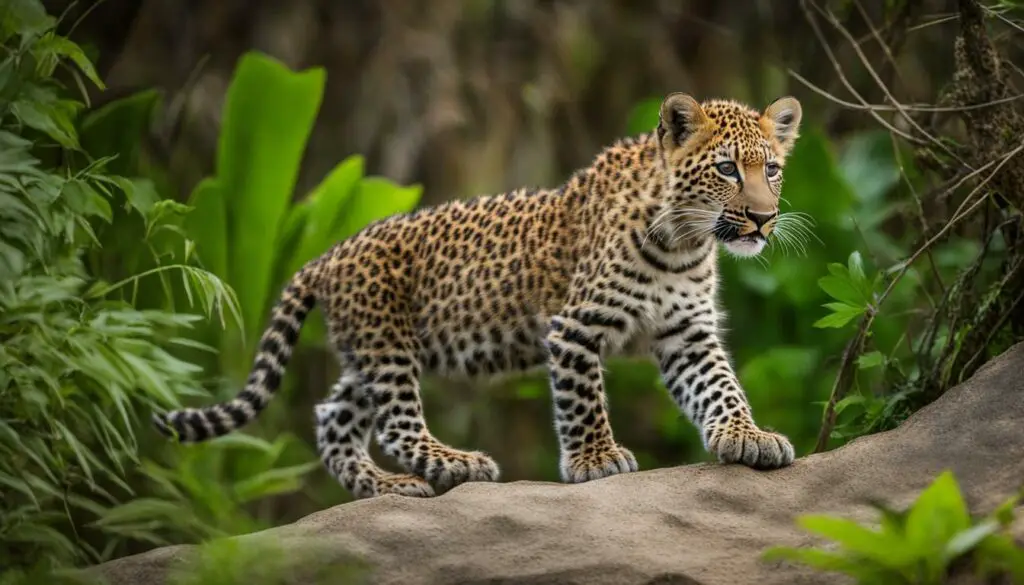
Let us come together to protect these remarkable creatures and celebrate the beauty and resilience of leopard cubs. By taking action and supporting conservation efforts, we can make a significant difference and secure a brighter future for leopard cubs and the entire leopard population.
Habitat and Behavior of Leopards
Leopards are fascinating creatures known for their adaptability and solitary nature. They can thrive in various habitats, including rainforests, deserts, woodlands, and mountainous regions. Their ability to survive in a wide range of environments is a testament to their resilience and flexibility.
These majestic cats are skilled hunters and primarily nocturnal, meaning they are most active during the night. Their exceptional camouflaging abilities and stealthy movements make them efficient predators, allowing them to stalk and capture their prey with precision.
Leopards have a diverse diet and are considered carnivores. They will feast on a range of animals, including antelopes, monkeys, and large birds. Their hunting techniques and strategies vary depending on the habitat and the availability of prey.
| Leopard Behavior | Habitat |
|---|---|
| Nocturnal hunting | Rainforests |
| Solitary nature | Deserts |
| Stealthy movements | Woodlands |
| Wide range of prey | Mountainous regions |
Leopards are truly remarkable creatures, with their ability to thrive in diverse habitats and adapt to different hunting conditions. Observing their behavior in the wild is a unique experience that offers valuable insights into the delicate balance of nature.
Understanding the habitat and behavior of leopards is essential for efforts to conserve their populations. By preserving their natural habitats and raising awareness about their importance, we can contribute to the long-term survival of these magnificent animals.
As we continue to learn more about leopards and their behavior, it becomes clear that they are a crucial part of our ecosystem. Their presence brings balance and diversity to the natural world, and it is our responsibility to protect them for future generations.
Size and Classification of Leopards
Leopards are fascinating creatures that fall into the category of large cats, although they are considered the smallest among them. These majestic animals can grow to be 3 to 6.2 feet long, with an additional 25 to 39 inches added to their length by their long and flexible tail. Female leopards typically weigh between 46 and 132 pounds, while males are slightly larger, weighing around 80 to 165 pounds.
Leopards are classified as catlike carnivores and belong to the Panthera pardus species. Within this species, there are various subspecies, each with its unique characteristics. Some well-known subspecies include the African leopard, which is found in Africa, and the Amur leopard, which is native to the Russian Far East and Northeast China. Each subspecies has its own distinct features and adaptations that allow them to thrive in their respective habitats.
To give you a visual understanding of how leopards compare to other animals, take a look at the table below:
| Animal | Average Length | Average Weight |
|---|---|---|
| House Cat | 1.5 – 2 feet | 5 – 12 pounds |
| Leopard | 3 – 6.2 feet | 46 – 165 pounds |
| Lion | 6 – 8.5 feet | 265 – 420 pounds |
| Tiger | 8 – 10.5 feet | 240 – 670 pounds |
As you can see, leopards are larger than house cats but relatively smaller when compared to their mighty cousins, lions and tigers. Their size allows them to move swiftly and gracefully through their habitats, making them excellent hunters.
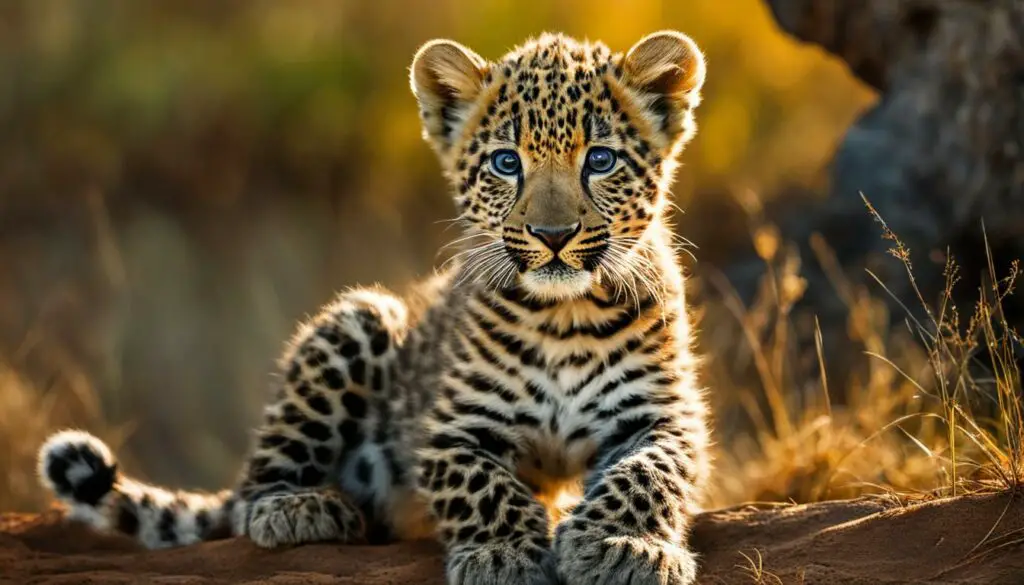
Interesting Fact:
“A leopard’s spots are unique, just like a human fingerprint. No two leopards have the same pattern!”
Threats to Leopard Cubs and Conservation Efforts
Leopard cubs, like their adult counterparts, face numerous threats in the wild that put their survival at risk. One of the primary threats is habitat loss, which occurs due to human activities such as deforestation. As natural habitats are destroyed or fragmented, leopard cubs lose crucial resources and face challenges in finding suitable prey and shelter. This loss of habitat also increases the risk of human-wildlife conflict, as leopards are forced to venture into human settlements in search of food and territory.
Another significant threat to leopard cubs is illegal hunting and poaching. Leopards are hunted for their striking fur, which is highly valued in the illegal wildlife trade. Additionally, their body parts are sought after for traditional medicine and decorative purposes. This demand drives the poaching of leopard cubs and adults alike, further endangering their already vulnerable populations.
To combat these threats and protect leopard cubs, various conservation efforts are in place. Organizations and initiatives work tirelessly to raise awareness about the importance of leopard conservation and advocate for stronger protective measures. They also collaborate with local communities to promote sustainable practices that minimize human-wildlife conflicts and support the preservation of leopard habitats.
| Threats to Leopard Cubs | Conservation Efforts |
|---|---|
| Habitat loss due to deforestation | Advocacy for stronger protective measures |
| Illegal hunting and poaching | Raising awareness about leopard conservation |
| Human-wildlife conflict | Collaboration with local communities |
By focusing on these conservation efforts, we can help safeguard the future of leopard cubs and preserve their natural habitats. It is crucial to support initiatives that promote sustainable practices and raise awareness about the value of these magnificent creatures. Together, we can make a difference in ensuring that leopard cubs thrive in the wild for generations to come.
Quote:
“Leopard cubs are a vital part of the ecosystem, and their conservation is essential for maintaining the balance of nature.” – Wildlife Conservationist
Conclusion
Leopard cubs go through various stages of growth and development under the care of their mother. From being born blind and helpless to becoming independent hunters, they learn important skills and behaviors from their mothers. These cubs start by relying entirely on their mother for care and protection, gradually opening their eyes, learning to eat solid food, and following their mother to learn hunting behaviors.
Conservation efforts are crucial to ensure the survival of these magnificent creatures and allow future generations to witness their beauty and grace in the wild. With our support and understanding, we can help protect leopard cubs and preserve their habitats for the years to come. The challenges faced by leopard cubs include habitat loss and hunting, which contribute to their declining population. Organizations and initiatives are working tirelessly to raise awareness and implement conservation measures to protect these incredible animals and their habitats.
By understanding the fascinating facts about leopard cubs and their behavior, we can appreciate the importance of safeguarding their future. These cubs hold immense value in maintaining the biodiversity of our ecosystem and deserve our utmost care and protection. Let’s continue to learn about and spread awareness of leopard cub facts and behavior, supporting conservation efforts for these iconic and enigmatic creatures.
What are the similarities and differences in the growth and development of leopard and cheetah cubs?
The cheetah cub development stages and the growth of leopard cubs share some similarities, such as the reliance on their mothers for nourishment and protection during the early stages. However, differences arise in their hunting techniques; cheetah cubs learn to chase prey at a much earlier age than leopard cubs.
FAQ
How long does it take for leopard cubs to grow and develop?
Leopard cubs go through various stages of growth and development. They are born blind and helpless, relying entirely on their mother for care and protection. They open their eyes at around 7 days old and start following their mother at 3 months old. They become independent of their mothers at 18 to 22 months old.
How long do leopard cubs live?
In captivity, leopard cubs have the potential to live for as long as 23 years. However, in the wild, their life expectancy is shorter, typically around 12 to 15 years due to various challenges they face.
Where do leopards live and what are their behaviors?
Leopards are adaptable and can live in a variety of habitats, including rainforests, deserts, woodlands, and mountain habitats. They are solitary creatures that spend most of their time alone, except when mating or raising young. Leopards are nocturnal hunters, relying on their exceptional camouflaging abilities and stealthy movements to catch their prey.
How big do leopards grow and what species do they belong to?
Leopards are larger than house cats but are considered the smallest members of the large cat category. They grow to be 3 to 6.2 feet long, with their tail adding another 25 to 39 inches to their length. Female leopards typically weigh 46 to 132 pounds, while males weigh around 80 to 165 pounds. Leopards belong to the Panthera pardus species.
What are the threats to leopard cubs and what conservation efforts are being made?
Leopard cubs, along with adult leopards, face threats such as habitat loss and hunting for their fur and body parts. They are listed as near threatened by the International Union for Conservation of Nature (IUCN). Conservation efforts are essential to protect these incredible animals and their habitats. Organizations and initiatives are working towards preserving their populations and raising awareness about the importance of conservation.

